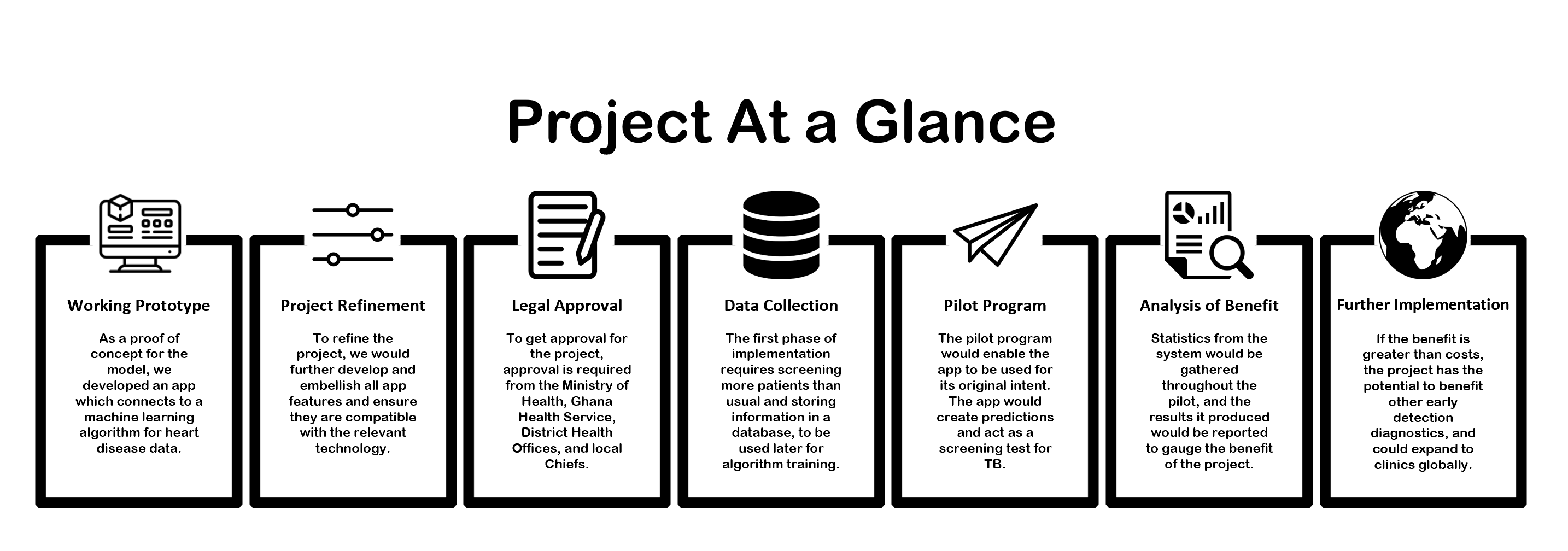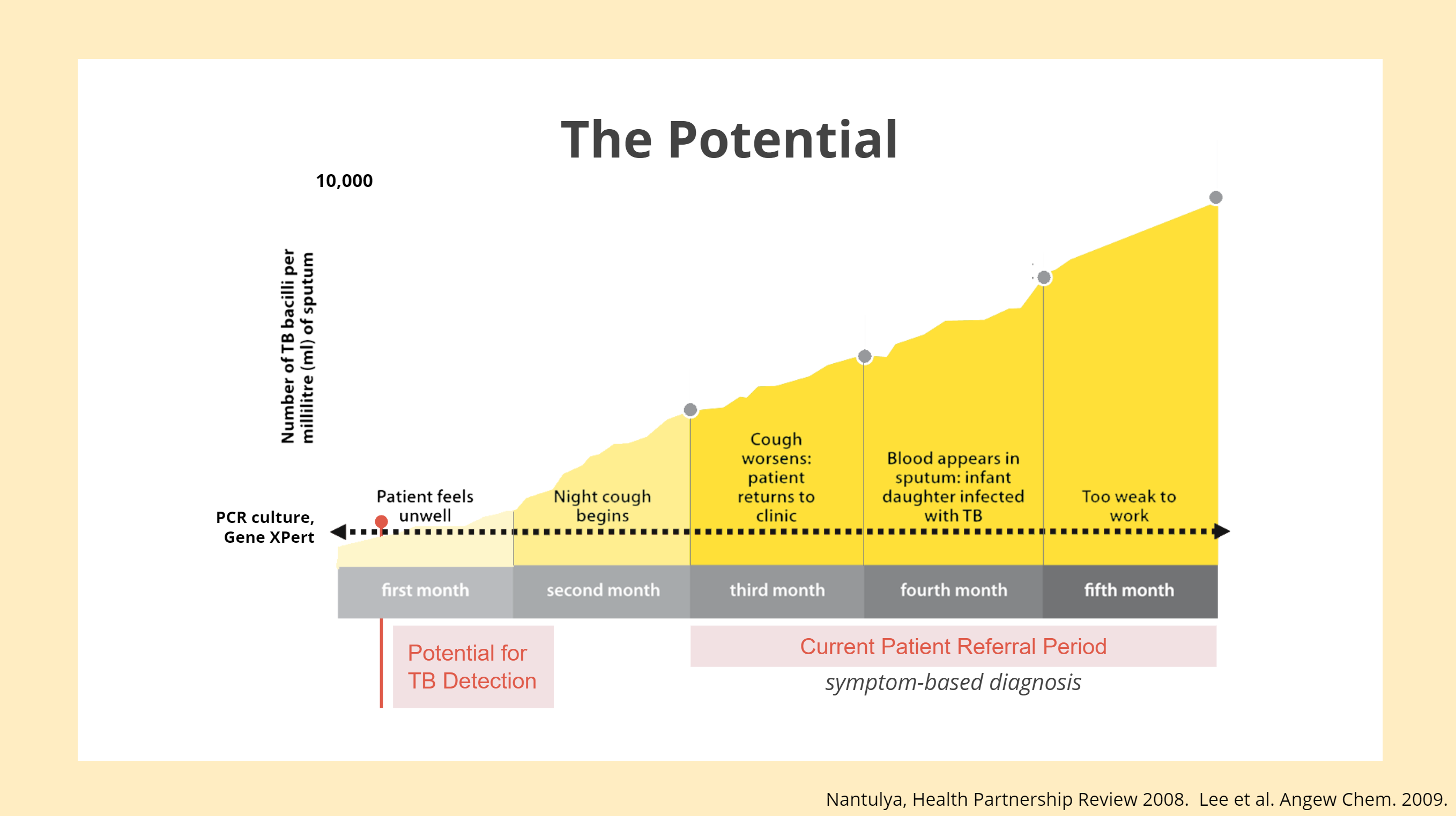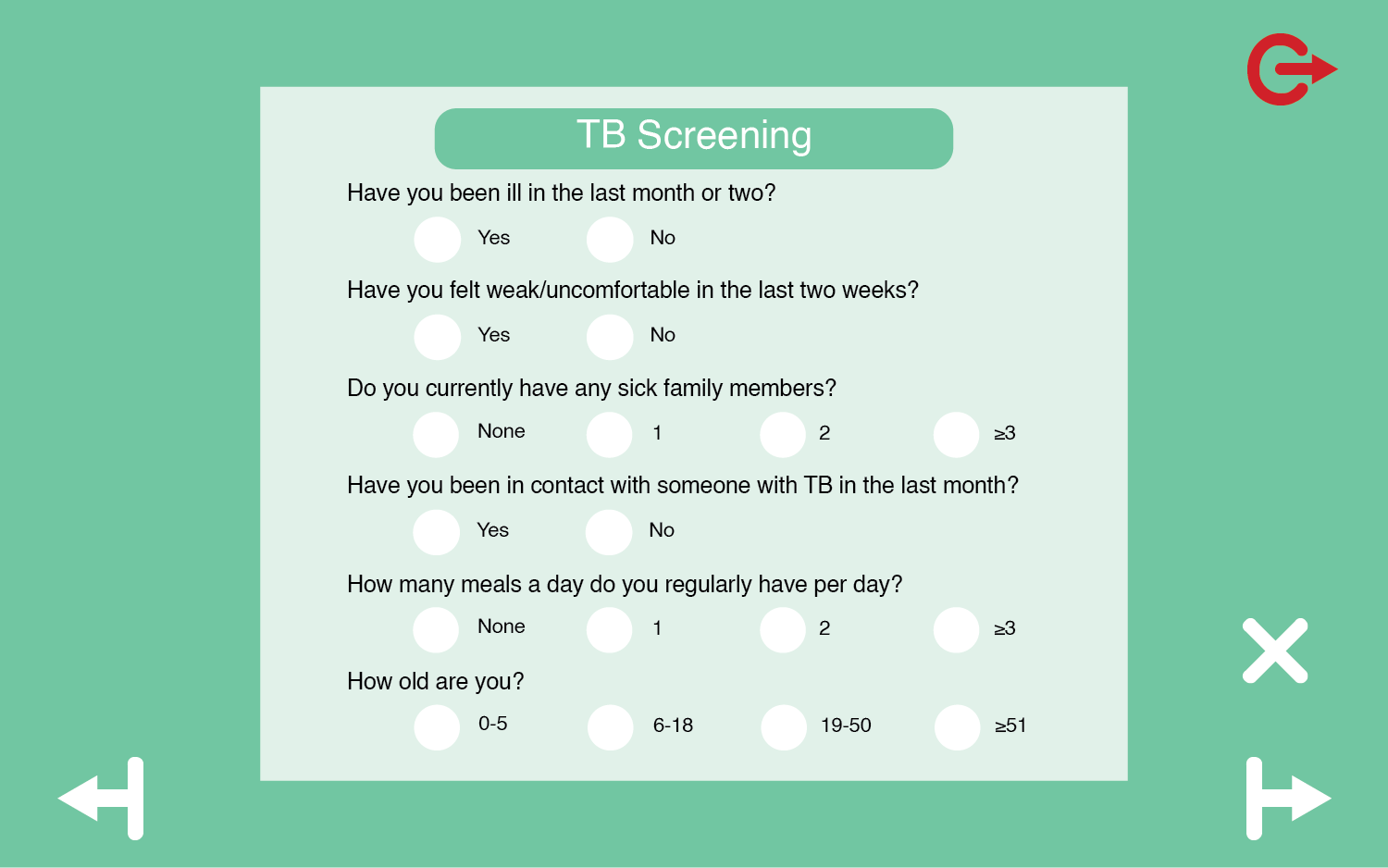MLEADS
Machine Learning Early Detection System
This project is maintained by the 2019 APOC Team
Appropriate Point of Care Diagnostics, Class of 2019.
Program Aim: To design self-contained, portable, medical diagnostics to provide high quality medical care in resource limited settings.
Program Structure: 5 months research and study on TB in Ghana. Project proposal. 3 weeks clinic and hospital visits in Ghana.
Project aim: To reduce the number of early stage TB patients missed by the current triage system implemented in government health facilities in Ghana.
OVERVIEW

ABSTRACT: There are many diseases that afflict people in our current generation, ranging from infectious diseases to noncommunicable diseases. Most of these diseases are easily diagnosable with the correct medical technology, with many of these technologies allowing for the early diagnosis of disease to allow for early treatment to control the progression of the disease, spread of infectious diseases, prevent further complications, and enable better management of the diseases. The use of these early detection technologies of diseases however, tends to be limited to a patient-referral system that depends on a number of factors that decide who is most at risk of being inflicted by a particular ailment and the factors may vary wildly based on the location, resources and lifestyle even though correlations for at-risk patients could exist. Our project utilizes machine learning algorithms that can be coupled with existing medical databases to recognize these trends and correlations between at-risk patients and serve as an assistive technology that can help doctors decide whether or not to suggest early detection tests to their patients. Our pilot case study chooses tuberculosis for our database model in order to test our prototype, especially since tuberculosis is one of the leading causes of death for people afflicted with HIV and the early detection of tuberculosis would be very essential to early treatment of the disease and make it easier to manage it.
PROBLEM BACKGROUND
Tuberculosis is a bacterial infection that primarily affects the lungs and has potential peripheral effects in other organ systems. Symptoms of tuberculosis include coughing, loss of weight and appetite, fever, chills, night sweats, and loss of proper function in any of the affected organs, including lymph nodes, bones, kidneys, brain, spine, and skin. Source The tuberculosis bacteria tend to settle in the lungs and multiply to attack the respiratory system. In other cases, the bacteria can spread throughout the body via the blood and lymphatic system. Bacteria are extremely resilient and can be transmitted through the air by coughing or sharing eating areas. In a patient with a healthy immune system, the bacteria will be surrounded in mucous and engulfed in cells which attempt to fight it off, which block the alveoli. However, tuberculosis tends to be an opportunistic disease, targeting those with compromised immune systems, which leads to a high prevalence in people with HIV. Tuberculosis is currently the leading cause of death in HIV patients, with 32% of AIDS deaths in 2017 resulting from TB.
Worldwide, tuberculosis is one of the top 10 causes of death, with approximately 10 million new cases and 1.6 million deaths in 2017 alone. Africa accounts for 84% of those deaths. Source In most hospitals, especially those in Ghana’s Ashanti region, the current system implemented only refers patients who are showing symptoms of TB for TB tests which are mainly smear microscopy and GeneXPert tests. However, with the introduction of the GeneXpert in Ghana, it has now become possible for the early detection of tuberculosis before the symptomatic stage is reached. This is because for tuberculosis testing, unless the patient is showing symptoms, TB testing is not done. However, we know that tuberculosis infected patients only start to show symptoms such as cough within the second or third month, though they are infectious by the second month.

Above is a graphic depicting the timeline for the progression of Tuberculosis.
As patients can visit the clinic as scarcely as every 3-6 months, symptom-based screening for tuberculosis is not the most effective solution to early TB detection, as it disregards most early cases of TB in which symptoms have not yet surfaced. For example, if a patient comes to the clinic in the second month of disease progression, they currently will not be tested for TB, and the next routine appointment would fall in month 5 of disease progression, where the patient grows too sick to work.
PROPOSED SOLUTION
Our project proposes to identify more asymptomatic tuberculosis cases currently missed with machine learning in order to increase the effort to further eradicate the disease from Ghana. We propose to train nurses in clinics to operate a tablet-based app, which allows them to enter patient data in accordance with a variety of screening questions. The data from the app, once submitted, communicates with a computer program in python. The program will then pass the data through a machine learning algorithm of our design which will be trained by an existing dataset containing patient data and diagnoses. The algorithm, once trained, will be able to take in new survey inputs and output a likelihood in which the patient has TB, which can then aid the doctor’s decision regarding whether or not to refer the patient to a laboratory or a TB clinic for further examination.
Why Machine Learning? Machine learning, a subset of artificial intelligence, is the scientific study of algorithms and statistical models that computer systems use in order to perform a specific task effectively without using explicit instructions, relying on patterns and inference instead. Source It provides a method for which patterns and correlations between large datasets can be studied where analysis would be too complicated for humans to interpret otherwise. Machine learning systems are constantly learning from their datasets and, as such, are able to update their output results over time. The constant retraining of data enables time trends to be studied and ensures that the algorithms remain applicable to such a dynamic dataset.
PROJECT WALKTHROUGH
In java, the team created an app with the user interface for inputting patient data. The app features a language selection page, followed by a login page. For demonstrative purposes, the app interface is shown in English. In a future implementation of the project, it would also feature Twi and any other language specific to the area in which the project is to be implemented. The language selection page is featured below.

The app is only intended for nurses and trained professionals to use. As such, to protect the integrity of the dataset and security of patient information, we added a login feature before opening the app. Ideally, each nurse will be given their own username and password which will be added to a text file which the java program reads. The login page graphic and corresponding backend code are displayed below.
In the implementation of the project, the login feature would be converted to a more secure API. The backend code and login feature were created and integrated in the GUI for demonstrative purposes.
Login graphic:

Current Login Functionality:
import java.io.; import java.util.; public class LoginBackend { public final String filename;
private boolean valid;
private HashMap<String, String> users;
public LoginBackend(String name) throws IOException {
filename = name;
valid = false;
users = new HashMap<String, String>();
try {
String line = "";
String user = "";
String pass = "";
BufferedReader reader = new BufferedReader(new FileReader(new File(filename)));
line = reader.readLine();
while (line != null) {
Scanner sc = new Scanner(line).useDelimiter(",");
user = sc.next();
pass = sc.next();
users.put(user, pass);
sc.close();
line = reader.readLine();
}
reader.close();
} catch (FileNotFoundException e) {
System.out.println("File not found");
}
}
if (users.containsKey(user) && users.get(user).equals(pass)) {
valid = true;
}
return valid;
}
}
Once the nurse has successfully logged in, the app then progresses to the main survey. The survey contains interactive buttons and text fields for nurses and medical professionals to input as they meet with the patient. Our current survey includes questions revolving around heart disease, as we used a dataset for heart disease as a proof of concept for the project. Once implemented, the survey would include approximately 10 questions revolving around tuberculosis, measuring a variety of attributes such as prior exposure, potential risk factors, symptoms, and other patient data.

When the nurse clicks the submit button, the java program parses through each question and ensures a valid answer is entered. If the program finds an option is not chosen for a multiple choice question or a text box has an inadequate or non-number input, it will display an error message and will not progress until all entries are valid. Once the inputs are verified, the program writes the data to a text file and subsquently runs a python program designed by the team to process the data with the machine learning algorithm. The python program reads the text file and runs the data through the algorithm. Once results are gathered, the python program writes the results in a second text file. As the python program finishes, the java program continues, reading from the new text file with the output and displaying the result in a pop up message to the app user.
Python algorithm:
def main():
database_file="C:/githubProjects/APOC-2019/heart_ML_data.csv"
input_file="C:/githubProjects/APOC-2019/APOCFinalGUI/entry.txt"
#loading the data
dataset = pandas.read_csv(database_file)
f = open(input_file, "r")
user_content = f.read()
user_content_array = user_content.split(",")
user_content_array[0] = int(user_content_array[0])
user_content_array[1] = int(user_content_array[1])
user_content_array[2] = int(user_content_array[2])
user_content_array[3] = int(user_content_array[3])
user_content_array[4] = int(user_content_array[4])
user_content_array[5] = int(user_content_array[5])
# Split-out validation dataset
array = dataset.values
X = array[:,0:6]
Y = array[:,6]
validation_size = 0.20
seed = 7
X_train, X_validation, Y_train, Y_validation = model_selection.train_test_split(X, Y, test_size=validation_size, random_state=seed)
# Test options and evaluation metric
seed = 7
scoring = 'accuracy'
# Spot Check Algorithms
models = []
models.append(('LR', LogisticRegression(solver='liblinear', multi_class='ovr')))
models.append(('LDA', LinearDiscriminantAnalysis()))
models.append(('KNN', KNeighborsClassifier()))
models.append(('CART', DecisionTreeClassifier()))
models.append(('NB', GaussianNB()))
models.append(('SVM', SVC(gamma='auto')))
# evaluate each model in turn
results = []
names = []
return_percentage = 0
for name, model in models:
kfold = model_selection.KFold(n_splits=10, random_state=seed)
cv_results = model_selection.cross_val_score(model, X_train, Y_train, cv=kfold, scoring=scoring)
results.append(cv_results)
names.append(name)
msg = "%s: %f (%f)" % (name, cv_results.mean(), cv_results.std())
#get the percentage accuracy
if name == 'NB':
return_percentage = cv_results.mean()*100
print(msg)
# Make predictions on validation dataset and on user input
nb = GaussianNB()
nb.fit(X_train, Y_train)
predictions_test = nb.predict(X_validation)
prediction_input = [user_content_array]
prediction_return = nb.predict(prediction_input)
prediction_writer = open('C:/githubProjects/APOC-2019/APOCFinalGUI/prediction.txt', 'w')
prediction_writer.write(str(prediction_return[0])+','+str(return_percentage))
sys.exit(0)
if __name__ == '__main__':
main(
# database_file=sys.argv[1],
# input_file=sys.argv[2],
)
Output message:

Once the message with results are displayed, the user can simply exit and the page will reset itself. Should the project be implemented in health systems, the survey entry will be stored in a separate location, and an option will be added to look up a patient to enter their diagnosis following lab tests. This will allow the machine learning algorithm to update itself continually and adapt to any changes in trends with patient data. A separate diagnosis page would be implemented to look up patients, and lab technicians or other relevant medical professionals will be trained to input diagnoses based on lab results.
Further Applications/ Project Adaptations
Below is a mock up of he survey interface should the app be modified to encompass TB diagnostics.

Should the project be implemented, the TB Screening page, as well as a page with patient vitals signs, would be displayed on the app and used in clinics. The survey questions currently attempt to address alternate symptoms, prior exposure to the disease, and other risk factors.
NEXT STEPS

Phase 1: Project Refinement
As previously stated, some aspects of the project were left unimplemented for demonstration purposes. To refine the project for implementation, a few tasks would ensue:
- Creating a more secure login feature
- Updating the interface/ data storage process to allow for continuous algorithm retraining and diagnosis updates
- Implementing dfferent language options with the GUI
- Adapt the survey questions to our desired implementation
Once the GUI is updated with the above feature, it is ready for field implementation.
Phase 2: Legal Approval
In order to implement the project as a pilot programme, it needs approval from a variety of organizations. The team would compose a letter to the Ghana Ministry of Health introducing the project, its potential benefits, and a plan for implementation.
Once the Ministry of Health approves the project, another letter would be drafted and sent to the Ghana Health Service, outlining the project and attaching the MoH letter of approval. The important portion of the requests would be to specify how we plan to protect patient confidentiality thorughout implementation of the project.
After approval from the Ghana Health Service, the next step would be to get approval from District Health Directories, which would again involve writing a letter for approval. Finally, to implement the project, approval from the local chief(s) is necessary. Once the chief approves the project, it is ready to be run as a pilot in clinics.
Phase 3: Pilot Programme, Data Collection
The project needs a large dataset in order for the algorithm to produce reliable resuts. As such, the first stage of the pilot programme would involve gathering a large set of patient data over the course of 3-6 months. A number of patients who normally are not screened for tuberculosis would be tested and screened by the survey. Their data and diagnosis would then be stored in a database as nurses and doctors screen more patients. Ideally, by the end of 6 months, the dataset should be sizable enough to provide results with a desired accuracy for the project. After the data collection phase, patients should not need to be tested unless the screening test advises they do so.
Phase 4: Pilot Programme, Algorithm testing
Once the database has grown to the desired size, the data will be run through the python script which will train a variety of machine learning algorithms. Once finished, the algorithm with the greatest accuracy during testing will be integrated within the main GUI. The GUI will then be ready for use and nurses will be trained in the clinic on how to use the app and enter patient data. Routinely, a number of patients should be tested regardless of screening results to ensure the continuing accuracy of the program. Externally, we will keep track of statistics regarding patient test results compared with screening results.
Phase 5: Analysis of Benefit, Result Report
At the end of the testing period, a variety of statistics would be recorded to analyze the benefit of the project. Examples of statistics to collect would include number of early cases caught, number of false positives and negatives to demonstrate specificity and sensitivity of the algorithm, and system accuracy percentages. The statistics of the project would be compared with costs of implementation and increased tuberculosis tests to understand the effects of the project on the health system in Ghana, and such information would additionally be summarized in a report. If the project results in a benefit which outweighs costs of implementation, the team will consider recommending the project as a permanent addition to Ghanaian health clinics and look to grow the initiative.
Further Steps
Machine learning shows promising performance with regard to early diagnostic tools, which has applications that extend far beyond tuberculosis. An extension for the project would include implementing it in other areas of clinics and applying the principles of machine learning to more infectious diseases, non-communicable diseases, and other medical conditions. Machine learning has the potential to be used as the main diagnostic for a variety of diseases, and its use would benefit the medical community in that it can help continue eradicating coniditions that currently plague Ghana by flagging more patients for testing.